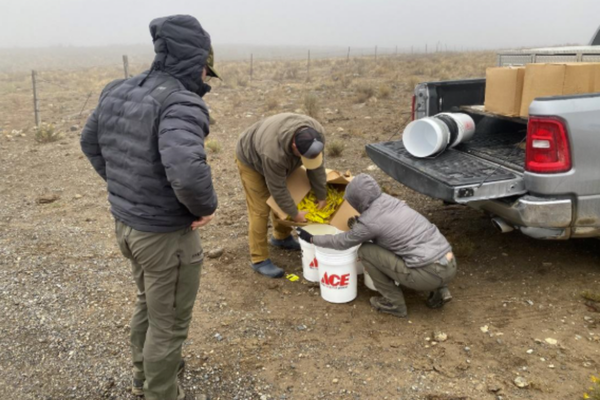Grizzly Bear Bill Heads to House Floor
Getty Images
Senate Bill 1027 will facilitate state management of grizzlies, hunting and rule making when de-listed
Grizzlies from the Greater Yellowstone Ecosystem are on the rebound! Their numbers have recovered and surpassed the original goals- a testament to the effectiveness of the Endangered Species Act. The USFWS has recommended that the Yellowstone grizzly be taken off the threatened list.
The Endangered Species Act is intended to lead to recovery and delisting, and ensure adequate plans are in place so a species won’t go back to the list. Senate Bill 1027 is one step towards putting state plans in place to manage the grizzly for sustainable or improved populations. One management tool will involve the creation of hunting seasons, rules, and regulations. So IWF testified in favor of the bill with a “Do Pass” recommendation to the House floor and it passed. After House floor, the Governor’s desk.
We believe it is time for the grizzly to come off the endangered species list, and for the Idaho Department of Fish and Game to manage the species. Fish and Game has a proven track-record when it comes to predator management. Idaho black bear, wolves, and cougar populations are on the rise all while we have experienced the best four years of big game harvest numbers in several decades for hunting elk, mule deer, and pronghorn.
In the first years it might only be appropriate to allow hunting close to core grizzly habitat, where populations are currently resilient enough for hunting. And any money generated from grizzly hunting should be allocated to programs that aid grizzly sustainability such as funding for grizzly poaching enforcement, migration planning, bear boxes in campgrounds, wildlife overpasses, and so on.
Grizzlies also need to be managed in a way that wont send them back to the ESA List, which may require an update to our bear management plan which hasn’t been updated for a long time.
So what does this mean for Yellowstone grizzlies?
FICTION: Protections for Yellowstone grizzlies will disappear if they are taken off the list of the threatened and endangered species.
FACT: Over a decade of work has gone into creating a conservation package for Yellowstone’s grizzlies to ensure that the bears continue to thrive once taken of the list. Developed by federal and state natural resource management agencies, the Conservation Strategy provides an impressive set of protections. They include:
Designating a six million acre Primary Conservation Area where the needs of grizzlies come first. This conservation area includes the vast majority of lands in the Yellowstone ecosystem where bears currently live and contains the highest density grizzly habitats. Oil and gas development, mining and logging are severely constrained in this area. The Conservation Strategy also identifies an additional six million acres, surrounding the Primary Conservation Area, where the needs of bears must receive careful consideration. Much of this land is currently unoccupied by bears.
Protection against excessive take. State management plans include sustainable mortality limits that must not be exceeded.
Extensive monitoring. Food supplies, threats to habitat, population numbers and mortality rates will all be closely watched.
FICTION: Yellowstone grizzlies have nothing to gain from delisting.
FACT: A solid framework is in place to ensure that continued grizzly bear conservation will follow delisting. As the needs of Yellowstone grizzlies change or increase, so will the tools and protections needed to meet them.
Each state has identified potential habitat to accommodate continued grizzly population growth and expansion.
On U.S. Forest lands, no new livestock grazing allotments will be allowed in the Primary Conservation Area, and plans call for phasing out existing sheep allotments as opportunities occur. Allotment retirement programs are identified in these plans as the preferred approach to eliminate chronic grizzly/livestock conflicts.
The Interagency Grizzly Bear Study Team will increase the area where it monitors for trends in grizzly numbers and mortalities.
FICTION: Yellowstone grizzlies are not ready to be delisted.
FACT: All of the recovery goals—population, distribution and mortality—needed to qualify bears for release from the Endangered Species Act’s emergency room care have been met or exceeded. ÿ
Population Recovery Goal: The grizzly population must contain at least 15 adult females with cubs. Fact on the ground: The average over the past six years has been 40 female grizzlies with cubs. In 2002, 52 females with cubs were observed.
Distribution Recovery Goal: Adult female grizzlies with young must occupy at least 16 of the 18 bear management units that comprise the Primary Conservation Area in the Yellowstone ecosystem. Fact on the ground: This goal has been met since 1998. In four of the last six years, adult females with young have occupied all 18 units, according to the Interagency Grizzly Bear Study Team.
Mortality Recovery Goal: Overall bear mortality must be limited to no more than 4 percent of the total population. Fact on the ground: This goal has been met since 1996 with the exception of one year when the female mortality subquota was exceeded by a fraction.




